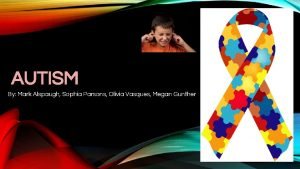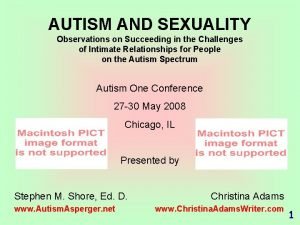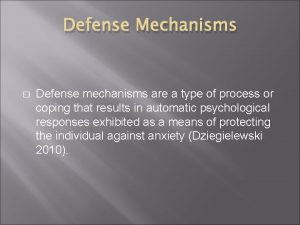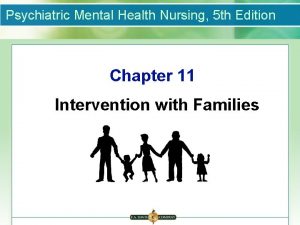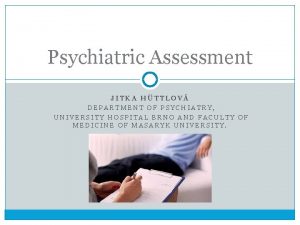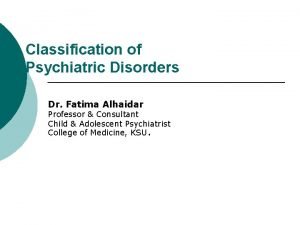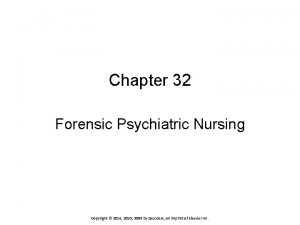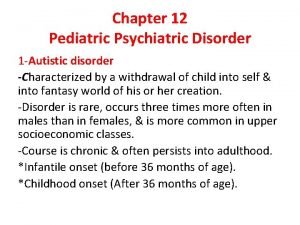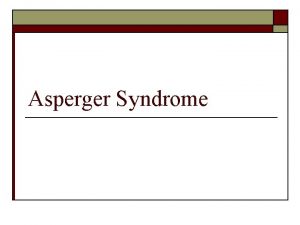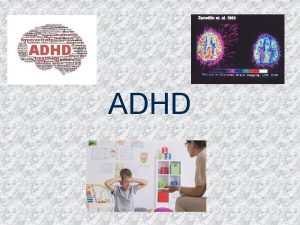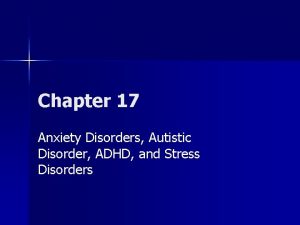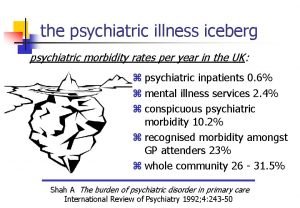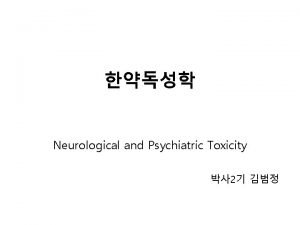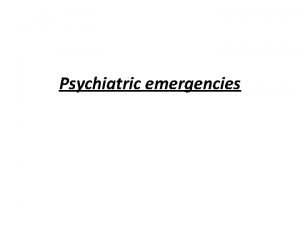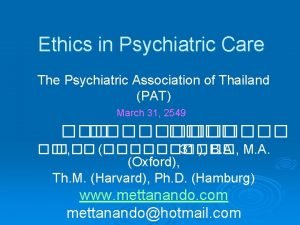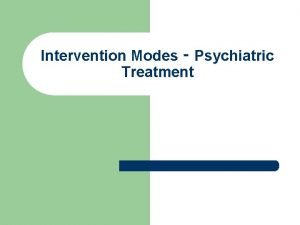Chapter 12 Pediatric Psychiatric Disorder 1 Autistic disorder













- Slides: 13

Chapter 12 Pediatric Psychiatric Disorder 1 -Autistic disorder -Characterized by a withdrawal of child into self & into fantasy world of his or her creation. -Disorder is rare, occurs three times more often in males than in females, & is more common in upper socioeconomic classes. -Course is chronic & often persists into adulthood. *Infantile onset (before 36 months of age). *Childhood onset (After 36 months of age).

Symptomatology (subjective & objective): 1 -Failure to form interpersonal r/s: *Characterized by unresponsiveness to people, lack of eye contact & facial responsiveness, indifferent affection *In early childhood there is a failure to develop cooperative play & friendships. 2 -Impairment in communication (verbal & non verbal): -Characterized by absence of language or, if developed often an immature grammatical structure, incorrect use of words, echolalia, or inability to use abstract forms. -Accompanying nonverbal expressions may be inappropriate or absent.

3 -Bizarre responses to environment characterized by resistance or extreme rxns to minor occurrences, abnormal obsessive attachment to peculiar objects, ritualistic behavior. 4 -Extreme fascination for objects that move (ex. Ram trains) special interest in music, playing with water, buttons, or parts of body. 5 -Unreasonable insistence on following routines in precise detail (ex. insisting that exactly same route always be followed when shopping). 6 -Marked distress over change in trivial aspects of environment (Ex: When a case is moved from usual position). 7 -Stereotyped body movements (Ex: hand flicking or hand twisting, hand banging, complex whole body movement).

Prognosis: -Language skills and overall intellectual level are the strongest factors related to ultimate prognosis. -Only a small percentage of pts. with disorder go on to live and work independently as adults. -In about one third of cases, some degree of partial independence is possible. -The highest functioning adults with autistic disorder typically continue to exhibit problems in social interaction & communication together with restricted interests & activities.

2 - Attention-Deficit Hyperactivity Disorder (ADHD) -Often appears before age 4 & characterized by developmentally inattention, impulsively & hyperactivity. -In approximately one third of cases, sx persist into adulthood.

Symptomatology: -Often fidgets with hands or feet or squirms in seat. -Has difficulty remaining seated when required to do so. -Is easily distracted by extraneous stimuli. -Has difficulty awaiting turn in games or group situations. -Often blurts out answers to questions before they have been completed. -Has difficulty following through on instructions from others. -Has difficulty sustaining attention in tasks play activities. -Often shifts from one uncompleted activity to another.

-Has difficulty playing quietly. -Often talks excessively. -Often interrupts or intrudes on others. -Often doesn’t seem to listen to what is being said to him or to her. -Often loses things necessary for tasks or activity at school or at home. -Often engages in physically dangerous activities without considering possible consequences (Ex: runs into street without looking).

Prognosis -In most cases, disorder is relatively stable through adolescence. -In most persons, sx are reduced into adolescence & adulthood, although few experience full range of sx into mid-adulthood. -Other adults retain only some of sx.

3 - Conduct disorder -Repetitive and persistent pattern of conduct in with the basic rights of others and major use – appropriate sour norms or rules are violated. The conduct is more serious than the ordinary mischief and pranks of children and adolescents.

Symptomatology: 1 -Manipulation of others for fulfillment of own desire 2 -Absence of guilt feelings in response to exploitation of others 3 -Physical violence against persons or property -Examples include vandalism, rape, breaking and entering, fire setting , mugging, assault, cruelty to animals -Child often initiates physical fights 4 -Thefts outside the home involving confrontation with the victim -Examples include extortion, purse snatching, armed robbery 5 -Inability to from close peer relationships 6 -Chronic violations of reasonable, age-appropriate rules. -Examples include truancy, running away, persistent lying stealing, substance abuse 7 -Failure to accept responsibility for consequences of own behavior

Prognosis: -Less severe sx tend to emerge initially. -Males dominate in the childhood-onset grows & tend to exhibit more fighting, stealing, vandalism, & school discipline problems. -Females tend to have sx of lying, running away, substance use, & prostitution. -Males tend to use more confrontational aggression, Female, uses non- confrontational behaviors. -An onset of conduct disorder before age 10 generally indicates more severe & persistent type & often develops into adult antisocial personality disorder. -These individuals typically are male, display more physical aggression.

4 - Oppositional defiant disorder - A pattern of negativistic, hostile, and defiant behavior without the more serious violations of the basic rights of others that are seem in those with conduct disorder. The diagnosis is made only if the oppositional and defiant behavior is much more common than seen in other people of the same mental age. The disorder most commonly begins in late childhood or early adolescence.

Symptomatology: 1 - Often loses temper 2 - Often argues with adults 3 - Often actively defies or refuses adult requests or rules 4 - Often deliberately does things that annoy other people 5 - Often blames others for his or her own mistakes 6 - Is often touchy or easily annoyed by others 7 - Is often angry and resentful 8 - Is often spiteful or vindictive 9 - Often swears or uses obscene language Prognosis: -Onset is typically gradual, usually occurring over
 Autistic adult
Autistic adult Is tim burton autistic
Is tim burton autistic Autism and relationships
Autism and relationships Autistic fantasy defense mechanism example
Autistic fantasy defense mechanism example The term behavioral crisis is most accurately defined as
The term behavioral crisis is most accurately defined as Chapter 11 psychiatric mental health nursin
Chapter 11 psychiatric mental health nursin Conversion disorder
Conversion disorder Mental health nursing definition according to who
Mental health nursing definition according to who Mood mse
Mood mse Nursing rationale examples
Nursing rationale examples First psychiatric nurse in india
First psychiatric nurse in india Psychological disorders
Psychological disorders Cmc psychiatric hospital
Cmc psychiatric hospital Role of psychiatric nurse
Role of psychiatric nurse

